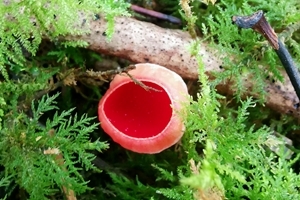Scarlet elf cup
 I try to write about something that is connected to the month, or a species that I either know about or one that I’d like to know more about, but this month it is more the case that this species is something that has caught my eye and does a little display if you know how to encourage it.
I try to write about something that is connected to the month, or a species that I either know about or one that I’d like to know more about, but this month it is more the case that this species is something that has caught my eye and does a little display if you know how to encourage it.
The scarlet elf cup (Sarcoscypha austriaca), as I know it (as it has many other common names), is lighting up all the woodlands I have been in recently. One particular woodland that comes to mind is one that I was in last week, which was carpeted with snowdrops, flowering hazel and calling goshawks echoing through the canopy, and it was littered with this mystical and cheery fungi brightening up the woodland floor with lots of red cups.
The scarlet elf cup is an ‘ascomycota’ fungus, the largest and most diverse group of extant fungi, which has compelling fossil evidence for the group extending back to the Devonian. Other evidence suggests that they may extend back to the Precambrian, the period of time extending from about 4.6 billion years ago, the point at which Earth began to form, to around 540 million years ago. Ascomycota fungus actively shoots its spores into the air, and in this case from within the surface of the red cup. This can be seen with the naked eye and the process also heard, as it makes a tiny puffing sound as the spores are released.
If you would like to see this, here’s a little trick: by blowing on them (ideally in March or April) you can trigger them to shoot clouds of spores. This is not the movement of your breath raising a cloud, but the slight change in temperature that it brings triggering many thousands of spores into being expelled from the inner surface of the cup by a pump action. So, if you would like to give this a go, this time of year is best, and it also helps disperse the spores to enable more scarlet elf cup to grow!
As the name suggests, the cups of the scarlet elf cup are cup-shaped and scarlet, but they can also be orange in colour. The stipe (stalk) is hard to see and attached to the leaf litter below, is the same colour of the outside of the cup, and is only up to 3.5cm long, giving the appearance that the hollow little bowls are just lying on the woodland floor or on decaying branches.
As I said, scarlet elf cups have many other common names, which include, the scarlet elf cap, red cup, scarlet cup, moss cups and fairies’ baths. With that in mind, in European folklore, it was said that the wood elves drank morning dew from the cups or where the fairies bathe.
So where can you see these beautiful, jewel-like fungus? The scarlet elf cup is widespread but uncommon in Britain and Ireland, but the best place to find it is somewhere damp. It is a saprophyte or ‘decomposer fungus’, which eats deadwood and recycles it into nutrients, which are released back into the earth to support new plant life. It tends to grow in clusters together on dead deciduous branches such as hazel or sycamore, which is usually covered in moss and can be found on the woodland floor, where it can attach itself to leaf litter. As it likes to grow in damp places, I have also seen it growing on the side of shady wet ditches and stream banks.
Though not poisonous, it is considered inedible, but I have heard it has an earthy taste like beetroot. In the past, it has been used as a medicine by the Oneida Native Americans to stop bleeding, and was placed under bandages and on the navels of newborns to promote healing, but today it has no medicinal use.
So, with most things in nature, it is best to admire and leave the scarlet elf cup where you see it, in its natural environment, doing its job in the web of life. But do keep an eye out for them as they can be quite small but come in all shapes and sizes, and they are a true delight!
Megan Lock
Advisory